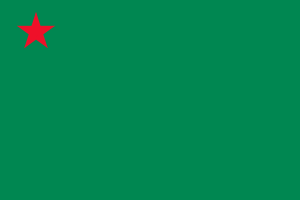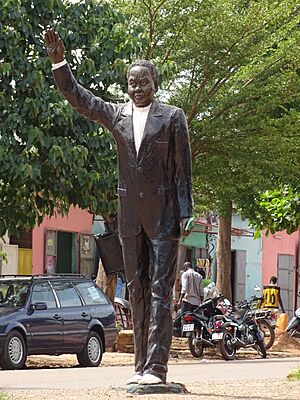Mathieu Kérékou facts for kids
Quick facts for kids
Mathieu Kérékou
|
|
|---|---|
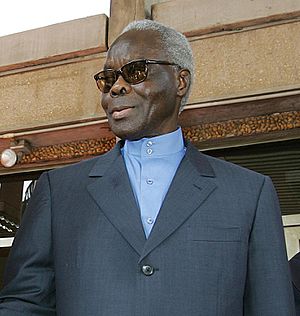
Kérékou in 2006
|
|
| President of Benin | |
| In office 4 April 1996 – 6 April 2006 |
|
| Preceded by | Nicéphore Soglo |
| Succeeded by | Thomas Boni Yayi |
| In office 26 October 1972 – 4 April 1991 |
|
| Preceded by | Justin Ahomadégbé-Tomêtin |
| Succeeded by | Nicéphore Soglo |
| Personal details | |
| Born | 2 September 1933 Kouarfa, French Dahomey |
| Died | 14 October 2015 (aged 82) Cotonou, Benin |
| Political party | Action Front for Renewal and Development |
| Other political affiliations |
People's Revolutionary Party of Benin (1975–1990) |
| Spouses | Symphorose Béatrice Lakoussan (divorced) Marguerite Kérékou |
| Signature |  |
Mathieu Kérékou (2 September 1933 – 14 October 2015) was an important politician from Benin, a country in West Africa. He served as the President of Benin for two separate periods. His first time as president was from 1972 to 1991. He then served again from 1996 to 2006.
Kérékou first came to power through a military takeover. He led the country for 19 years. For much of this time, Benin followed a political idea called Marxism–Leninism. This meant the government had strong control over the economy and society. Later, his powers were reduced by a special meeting in 1990. He lost the presidential election in 1991. However, he was elected president again in 1996 and won re-election in 2001.
Contents
Early Life and Military Career
Kérékou was born in 1933 in a village called Kouarfa. This village is in what was then French Dahomey. He went to military schools in Mali and Senegal. After his studies, he joined the French Army in 1960.
After Benin became independent, Kérékou served as an assistant to President Hubert Maga. This was from 1961 to 1963. In 1967, there was a military takeover led by Maurice Kouandété. Kérékou, who was Kouandété's cousin, became the head of a military council. After more military training in France, he became a major and a high-ranking officer.
Taking Power and One-Party Rule
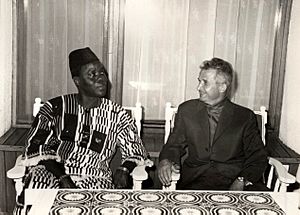
Kérékou took control of Dahomey in a military takeover on 26 October 1972. This ended a system where three leaders took turns being president.
At first, Kérékou said Benin would not copy any foreign political ideas. He wanted a unique Dahomeyan system. But on 30 November 1974, he announced that the country would follow Marxism-Leninism. A year later, the country's name changed from the Republic of Dahomey to the People's Republic of Benin. The government took control of banks and the oil industry. The People's Revolutionary Party of Benin became the only legal political party. Kérékou was elected president by the National Assembly in 1980. He left the army in 1987.
Some people believe Kérékou adopted Marxism-Leninism for practical reasons. It helped his government seem new and different. It also offered a way to unite the country. His government was very strict about its new ideas in the mid-1970s. They took over parts of the economy and changed the education system. They also tried to get rid of old traditions.
However, the economy stayed very weak. In the early 1980s, Kérékou started to change course. He closed many state-run companies. He also tried to attract money from other countries. In 1989, he agreed to a plan from the IMF. This plan meant the government had to spend much less money.
The economic problems got worse in the 1980s. This led to many protests in 1989. Students went on strike, and then other groups joined. At first, they protested about not getting paid. But soon, they demanded political changes.
Moving Towards Democracy
In the early 1990s, many African countries started moving towards democracy. Benin was one of the first. Kérékou had to agree to the people's demands. Benin's quick change to democracy was partly because its economy was in such bad shape.
In December 1989, Marxism-Leninism was no longer the official state idea. A big national meeting was held in February 1990. This meeting was not friendly to Kérékou. It declared itself the highest power in the country. Kérékou called this a "civilian coup." But he did not act against the meeting. He remained president but lost most of his power.
During this meeting, which was shown on TV, Kérékou spoke to the Archbishop of Cotonou. He admitted mistakes made during his rule and asked for forgiveness. This was a very unusual move for an African leader. It helped him regain trust from the people. It also protected him from being charged with crimes.
World Bank economist Nicéphore Soglo became the new prime minister in March 1990. A new constitution was approved in December 1990. Multi-party elections were held in March 1991. Kérékou lost this election to Prime Minister Soglo. He got about 32% of the votes. Kérékou became the first president in mainland Africa to lose power through a popular election. He apologized for "unfortunate events" that happened during his time in power. After losing, Kérékou stepped away from politics.
1996 Presidential Election
Kérékou became president again in the March 1996 election. Soglo's economic changes and his leadership style had made him unpopular. Kérékou received fewer votes than Soglo in the first round. But he won the second round with 52.5% of the votes. He had strong support from voters in the northern part of the country. Soglo claimed there was cheating, but the court confirmed Kérékou's win.
When Kérékou took his oath of office, he left out a part about "spirits of the ancestors." This was because he had become a born-again Christian. He was later made to retake the oath, including that part.
Disputed Re-election in 2001
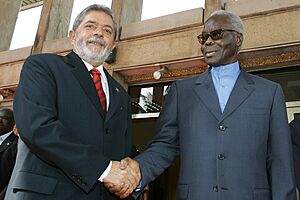
Kérékou was re-elected for a second five-year term in the March 2001 presidential election. This election was controversial. He got 45.4% of the votes in the first round. The second and third place candidates refused to take part in the second round. They claimed there was cheating. This meant the fourth-place candidate faced Kérékou in the final vote. Kérékou easily won with 83.6% of the votes.
During his second term, Kérékou's government followed a free-market economic path. Benin also took part in international peacekeeping missions in other African countries.
Kérékou was not allowed to run for president again in 2006. The constitution said a president could only serve two terms. It also said candidates had to be younger than 70. Kérékou turned 70 in 2003. In July 2005, he said he would not try to change the constitution. He said, "If you don't leave power, power will leave you."
On 5 March 2006, voters chose who would replace Kérékou. Yayi Boni won the election. Kérékou left office on 6 April 2006.
Religion and Symbolism
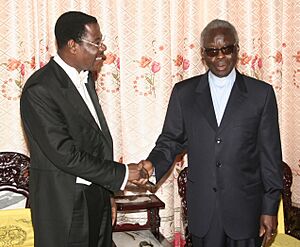
Kérékou was born and baptized into the Roman Catholic faith. He later reportedly converted to Islam in 1980 and changed his first name to Ahmed. However, he later went back to using the name Mathieu. This conversion might have been to please the Libyan leader Muammar Gaddafi and get financial help. Later, he became a born-again Christian. Some people in Benin who follow Vodun believed he had special powers. They thought this explained how he survived many coup attempts.
Kérékou was nicknamed "the chameleon" early in his career. His motto was "the branch will not break in the arms of the chameleon." This nickname and motto were full of cultural meaning. They showed his power and skill. The chameleon suggests cleverness and ability to adapt. His motto meant he would keep the country stable. It also hinted at what could happen if the country was not under his leadership. His nickname seemed fitting as he adapted to new political and economic ideas in the 1990s.
His campaign slogan was, "Experience in the service of youth."
Retirement and Death
After leaving office in 2006, Kérékou stayed out of politics. He spent his time at his homes in Cotonou and Natitingou. In 2014, he had a health problem and was taken to Paris for treatment. He got better, but continued to have health issues.
Mathieu Kérékou died in Benin on 14 October 2015, at the age of 82. President Thomas Boni Yayi announced his death. The cause of death was not stated. Benin declared a week of national mourning.
Images for kids
See also
 In Spanish: Mathieu Kérékou para niños
In Spanish: Mathieu Kérékou para niños


